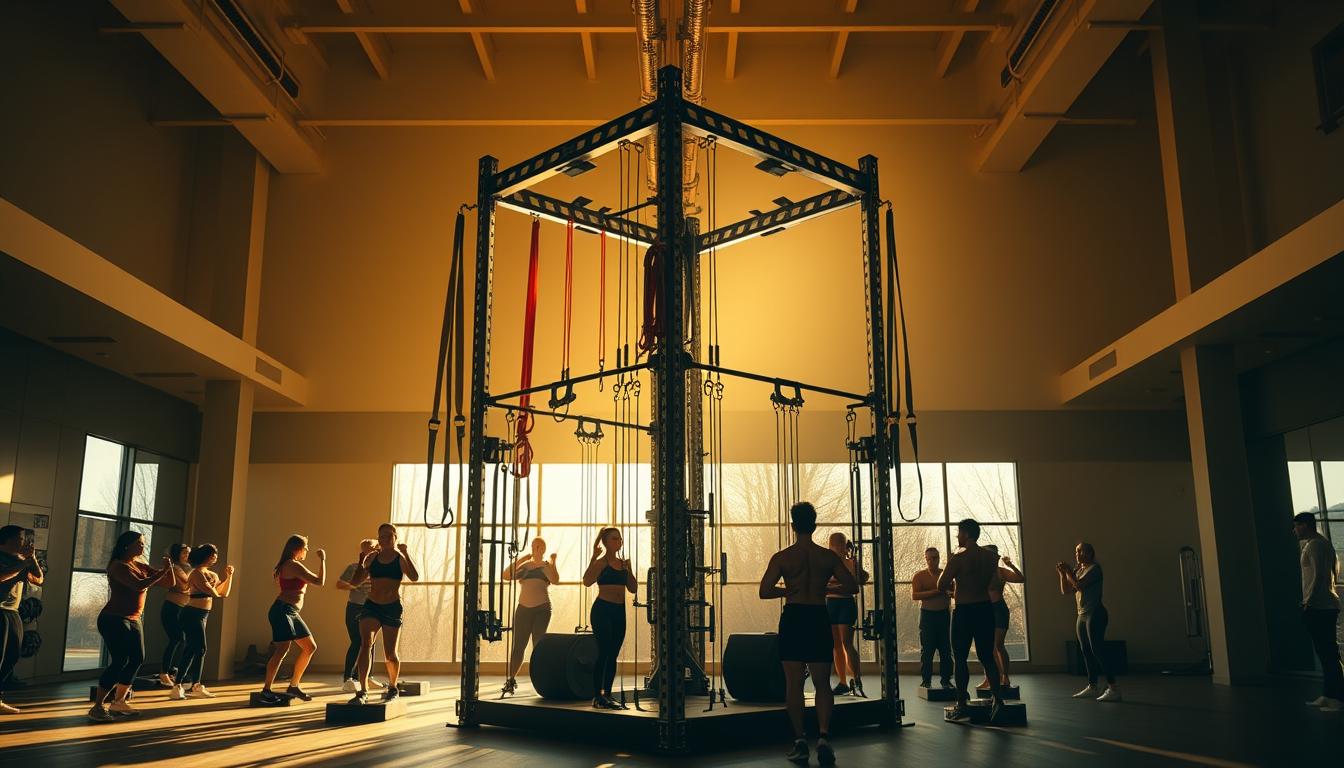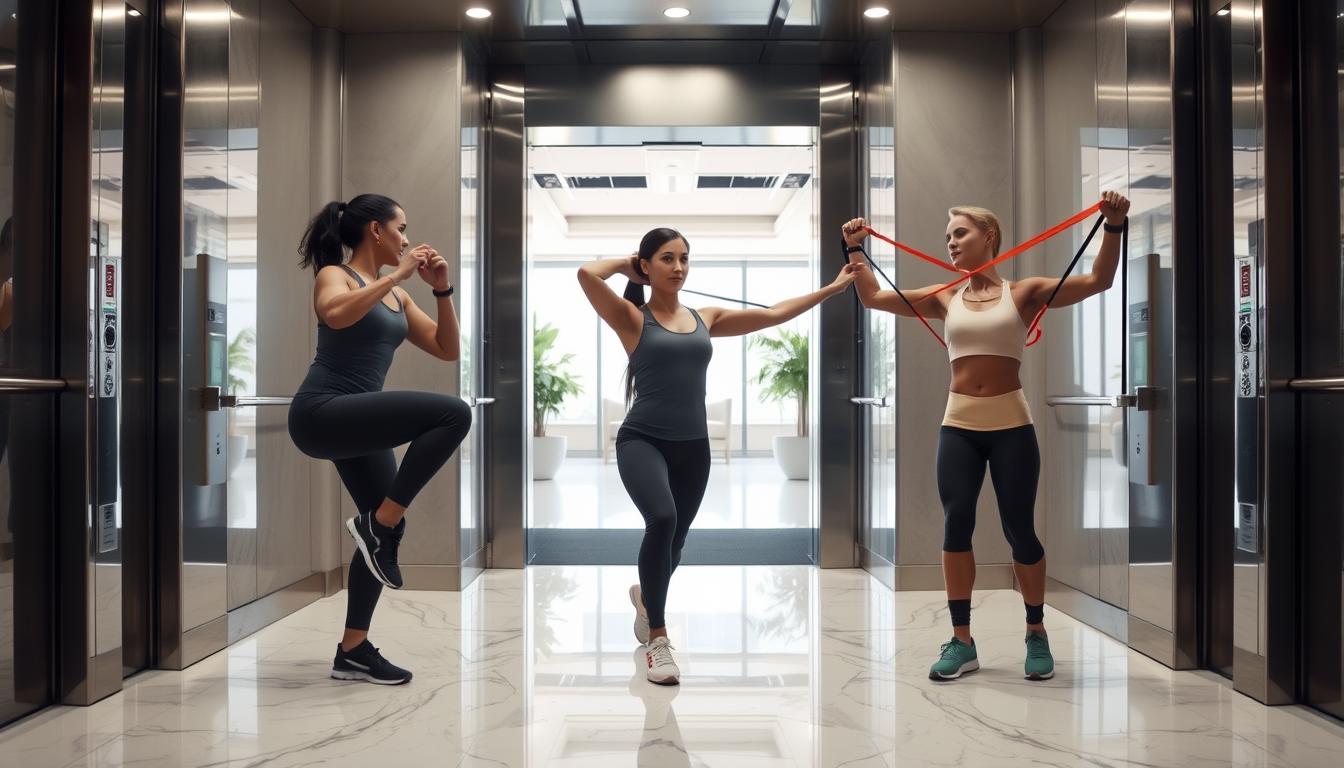The Elevator Core Workout Routine offers a great way to get a stronger core. It easily fits into your workout plan. This routine focuses on exercises that make your midsection better. It doesn’t just shape your abs, but also boosts your overall strength and fitness.
With this focused plan, you can see results fast. It’s perfect for those who want to make the most out of their exercise time. Next, we’ll show you why the core is so key and share tips on making it stronger.
What Muscles Make Up the Core
The core is made up of several key muscle groups. These groups work together to keep us stable and help us move efficiently. Knowing about these muscles is key to improving how we perform every day and reaching our fitness goals. The core includes muscles such as the transverse abdominis, rectus abdominis, obliques, multifidus, and erector spinae. Each one has a special job in keeping our posture upright, keeping our balance, and helping our trunk move.
Understanding Core Muscles
Think of the core as the body’s engine. It runs from the neck down to the pelvis. All the core muscles work as a team to keep us steady and supported no matter what we’re doing. The transverse abdominis wraps around our middle like a belt, keeping the pelvis stable. The rectus abdominis, our “six-pack” muscle, sits in the middle of our belly and helps bend our trunk. The obliques help with turning and side-bending.
The Role of Each Muscle Group
- Transverse Abdominis: This muscle is the deepest layer, wrapping around the midsection. It stabilizes the spine and keeps the pelvis in line.
- Rectus Abdominis: Running up and down the abdomen, this muscle is key for forward bending. It gives strength for movements that involve bending.
- External Obliques: These muscles stretch from the ribs to the pelvis diagonally. They help with turning the trunk and keep the core stable when we move.
- Internal Obliques: Sitting under the external obliques, they aid in turning and bending sideways. They help make the core stronger.
- Multifidus: Found in the back, this muscle supports the spine. It’s crucial for keeping us stable in different positions.
- Erector Spinae: This muscle group runs along the spine. It’s important for standing up straight and keeping a good posture.
Why You Should Train Your Core
Core training boosts your well-being in many ways. Strong core muscles help improve your posture. They also make you better at sports and daily tasks. A good core keeps your body stable. This means you’re less likely to get hurt during physical activities.
Benefits for Posture and Stability
Working on your core helps you stand tall and straight. When your core is strong, your spine aligns better. This means less back pain and easier daily activities. Actions like bending or lifting become smoother. Your stability improves in different positions.
Enhanced Athletic Performance
Athletes need a strong core for better performance. It helps with running, jumping, and throwing. A tough core means better balance and stability. This leads to more power and efficiency in sports. Core workouts are key for athletes to do their best.
How to Engage Your Core
Learning to engage your core well is key for better strength and balance. This is true for daily activities and working out. Core engagement lays the groundwork for overall fitness. It lets you use your core muscles to their best. By focusing on core bracing, you can improve workouts and avoid getting hurt.
Techniques for Proper Engagement
To correctly engage your core, begin with a deep breath and pull your belly button in towards your spine. Keep your pelvis in a neutral spot during the exercise. This technique uses both concentric and eccentric contractions.
Concentric contractions make muscles shorter, and eccentric contractions make them longer. Abdominal bracing helps stabilize your spine. Abdominal hollowing works by pulling your navel inward to activate deeper core muscles.
Exercises for Core Activation
Adding the right core activation exercises to your routine helps build core strength. Key exercises include:
- Plank
- Bird Dog
- Dead Bug
- Bridge
- Abdominal Draw
These exercises show the importance of using your core in different positions and situations. Activating your core while doing everyday things like sitting or lifting helps with support and control. By doing these core exercises, you boost balance and lower injury risks. This greatly improves your fitness regimen.
How to Strengthen Your Core
Strengthening your core is about doing various exercises that focus on key muscle groups. These muscles, like the erector spinae and rectus abdominis, are crucial for stability and strength. By working on a range of exercises, you can boost your mobility, balance, and posture.
Key Exercises to Include in Your Routine
Important core exercises are:
- Planks
- Bird Dogs
- Glute Bridges
- Dead Bugs
- Side Planks with Rotation
- Turkish Get-Ups
When doing these exercises, you engage your core muscles. For instance, in a Dead Bug, try to pull your belly button towards your spine. If you have back pain, you can modify exercises by moving slowly or doing less. Always pay attention to what your body tells you.
Variation and Challenge for Better Results
For a stronger core, mix in different movements such as:
- Single-arm Push Press
- Kettlebell Bridge Pullover
- Single-arm Floor Press Dead Bug
- Stability Ball Rollouts
- Bird Dog
Making your workouts harder over time is key for core strength. This can mean more weight, more reps, or new techniques. Adding exercises like Inchworms or Bear Crawls keeps things fun. These changes help make your core stronger.
The Best Exercises for a Strong Core
To build a strong core, you should do different workouts that target various muscles. The top core exercises improve both strength and stability. Mixing various exercises into your routine boosts fitness and performance.
Most Effective Core Workouts
Some exercises really help strengthen and stabilize your core. They include:
- Bicycle Crunches: Aim to do 20-30 reps in 3 sets, keeping your movements controlled.
- Bird Dog Exercise: This helps with stability and strengthens the core. Do 10 reps on each side, keeping your spine neutral.
- Leg Raises: They focus on the rectus abdominis and hip flexors. Try doing 10-15 reps.
- Side Plank: Stay in this position for 15-30 seconds on each side, focusing on your core.
- Russian Twists: Great for working the obliques, aim for 10-12 reps on each side.
Combining Strength and Stability Exercises
It’s good to mix strength and stability workouts for a complete core training. Consider adding these:
- Cable Woodchoppers: Boost rotational strength with 10-12 reps on each side.
- Med Ball V-Ups: These work several muscle groups at once. Go for 10-15 reps.
- Weighted Plank Rows: This combines core work with upper body movement, training anti-rotational strength.
- Farmer’s Carry: A full-body workout that also makes your core stable and improves grip strength.
Benefits of the Elevator Core Workout Routine
The Elevator Core Workout Routine shines with its elevator routine effectiveness. It’s a smart plan that gets you great results quickly. By mixing classic core strength moves with cardio, it gives you many fitness benefits. Your overall health gets a big boost.
Efficiency of the Elevator Routine
This workout focuses on important exercises like the Farmer’s Carry, Plank Knee-To-Nose, and Slam Ball Russian Twist. Each exercise targets key core muscles. They also help with stability and balance. Doing these exercises means you work out lots of muscles at once.
- Farmer’s Carry: Activates the transverse abdominis and obliques for improved stability.
- Plank Knee-To-Nose: Strengthens the rectus abdominis while enhancing coordination.
- Slam Ball Russian Twist: Promotes rotational strength and stability.
Impact on Overall Fitness
Doing this routine regularly makes big changes. You’ll have better posture and less back pain. This helps with day-to-day life. Athletes will see improvements in running, cycling, and lifting too. Plus, you’ll breathe easier, boost your heart health, and have better bladder control.
Working your deep core muscles two to three times a week also lowers injury risk. It’s a safe way to get more stable and balanced.
Beginner Exercises for Core Strengthening
Starting fitness with core exercises lays a solid foundation for overall strength and stability. Beginners can benefit from a series of simple movements that promote safe core training. The focus should be on mastering these beginner core exercises to cultivate essential strength while minimizing the risk of injury.
Introduction to Core Exercises
For newcomers to core training, it’s crucial to incorporate effective yet manageable exercises. Building strength begins with low-impact options such as:
- Planks
- Dead bugs
- Russian twists
- Bird dogs
- Pallof presses
These exercises serve as excellent entry points for those pursuing core strength. They ensure a safe and effective approach. Focus on engaging the core throughout each movement and maintain proper form to maximize benefits.
How to Safely Start Your Routine
Gradually incorporating core workouts into your routine is vital. Aim to train core muscles 2-3 times weekly, dedicating 15-30 minutes for each session. Start with exercises that require only body weight:
- High Plank Hold – 60 seconds
- Superman Raise – 60 seconds
- Bear Plank Shoulder Taps – 60 seconds
- Elbows-to-Knees Crunch – 60 seconds
- Hollow Body Full Extension – 60 seconds
As confidence builds, explore more dynamic moves like the 3-Minute AMRAP. This combines various exercises to keep the routine engaging. Adding progressive overload techniques, like longer planks or resistance, will strengthen your core over time.
Following a nutritious diet with lean proteins, complex carbs, and healthy fats supports core recovery and growth. Listen to your body; avoid poor form or overtraining. Embrace these beginner core exercises to start a safe and effective journey to a strong core.
Intermediate and Advanced Core Workout Techniques
Looking to step up your core workout? Intermediate and advanced techniques offer many ways to do it. These methods test your limits and make your core more stable. This helps boost your core strength safely. A well-planned approach greatly improves results.
Progressing Your Core Workouts
For those at an intermediate level, try adding moves like the Plank Walk. It works many core muscles together. Moving on, the Superman Swimmer is great for core stability. For those more advanced, TRX Mountain Climbers focus on the front core muscles. TRX Planks are excellent for stabilizing both the abs and lower back. A good workout plan includes 6 to 7 sessions a week, each lasting 30 to 40 minutes, over three weeks. This will steadily increase your core strength.
Challenging Your Core Stability
To really push your core, try exercises like the Side Knee-Tuck for the oblique muscles. The Pike adds challenge by targeting not just the core but also triceps and shoulders. Adding weights to exercises can further strengthen the core and improve posture. For example:
- Hollow holds with weight plates or dumbbells
- Weighted planks with dumbbells or resistance bands
- Russian twists with dumbbells or kettlebells
- Cable crunches
- Weighted get-ups
It’s important to keep your form right to get the most out of these exercises and avoid injury. Move with control and slowly add more weight to challenge yourself. By adding these advanced techniques to your workouts, you’ll build a stronger, tougher core.
Common Mistakes in Core Training
Proper technique is crucial for effective core training. Many mistakes can slow progress and cause injuries. It’s important to know these mistakes to keep your workout safe and effective.
Identifying Poor Form
Bad form is a common mistake in core training. For example, a rounded back during crunches makes them less effective and risky. Watch out for signs of bad form, like:
- Arching the back during shoulder presses or push-ups, suggesting weak core engagement.
- Leaning too much to one side during single-arm exercises, which hurts core balance.
- Lifting the lower back off the ground during hollowing exercises shows wrong core use.
- Holding breath during workouts lowers oxygen for muscles.
Always aim for a neutral spine and correct posture in core workouts. Add exercises like planks for stronger core stability. This also avoids harm from doing too many crunches.
Avoiding Overtraining
Not resting enough between workouts can lead to overtraining. This makes you tired and slows down your progress. Remember the following to avoid overdoing it:
- Skipped workouts can stop long-term improvement.
- Skipping cardio can keep fat on, hiding your muscles.
- Not changing your routine can make it less effective over time.
- Using hip flexors instead of core muscles during workouts is a mistake.
- Not making workouts harder over time can lead to no gains.
Having a well-rounded plan with rest days and varied exercises is key. It keeps you safe from injuries and helps you get better, lasting fitness results.

Integrating the Elevator Core Workout Routine into Your Regime
To add the Elevator Core Workout Routine to your fitness plan, start by setting up a balanced schedule. It’s important that it mixes both core workouts and cardio exercises. This combo is key for the best health results. You should do core exercises and cardio on different days. This keeps your body moving and improves fitness at all levels.
Creating a Balanced Workout Schedule
A good workout plan covers all areas of fitness. Here’s how you can blend it smoothly:
- Alternate days for cardio and core exercises. This helps your muscles recover and grow strong.
- Turn daily tasks into mini-workouts. Opt for the stairs instead of an elevator to boost core strength.
- Divide your workouts into small parts throughout your day. This makes exercise feel easier and more doable.
- Start with small, realistic fitness goals. Then, slowly add more challenge to keep improving.
Combining Cardio with Core Workouts
Mixing cardio with core workouts makes exercise fun and useful. Here’s a good way to do it:
- Try moves like Walking Lunge Hammer Drop and Side Lunge Thrust. They work many muscles at once and improve heart health.
- Add tools like the MostFit Core Hammer to challenge your strength and stamina.
- Choose exercises that suit all fitness levels. For example, swap weighted squats with seated leg extensions if needed.
Keep track of your fitness journey through journals or apps. Short, active moments throughout your day can boost heart health and fitness. A well-thought integration plan is essential for lasting health benefits.
Conclusion
The Elevator Core Workout Routine is key for anyone’s fitness plan. It highlights how crucial core workouts are for overall health. Knowing about your core muscles and using them right boosts your strength, balance, and fitness that you use every day. This helps you do better in everyday life and sports, leading to a healthier way of living.
Adding core exercises that work many muscles at once makes your workouts more effective. It helps with losing fat and getting a better body shape. Focusing on the right way to move, breathe, and gradually increasing your workout intensity lowers injury risks. You’ll see benefits like better posture and less back pain, improving your overall health.
Don’t forget, keeping a balanced fitness routine, including eating right and taking supplements, is very important. This approach helps you get lasting fitness results that match your goals. Staying true to these principles lets you enjoy all the benefits of being fit, building a strong base for a healthy life.



